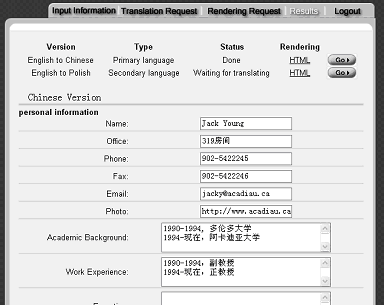
| Return | Projects | Collaborators | Publications | Bibliography |
I18N
Next, we developed a complete Globalization Framework (GF), a client/server-based internationalization system, using Cocoon, within which we tackled the following issues: (1) various representations of source data to be used in the globalization process and techniques for entering source data and their translations; (2) various kinds of persistent storage to efficiently store source data and their translations; (3) various representations of translation memories, and translation reusability; and (4) XML data compression.
An XML-based
Globalization Framework (GF) for building internationalized products was designed withe following high-level
requirements:
1. Multilingualism: support for issues such as right-to-left and vertical text rendering.
2. Efficiency: the framework will be efficient in terms of time and space.
3. Distribution: implementation of the framework allowing for cross-platform development.
4. Platform Independence: accessibility by users of heterogeneous systems.
5. Customizability: of both the framework and the final product.
6. Scalability: i.e., addition of new components to the framework does not hinder its performance.
7. Persistence and Reusability: of both source data and translations.
8. Low Cohesion: loosely connected components, allowing replacement of existing components and addition of new
components without affecting the operation of existing components
9. Portability: data can be moved between different kinds of persistent storage and network nodes.
GF is a structured environment, in which users are assigned separate roles; such as creators, translators and verifiers. Creators of the website submit a request, which defines the kind of information to be available on this website, provides complete source data in one or more languages, and specifies languages to which the source data are to be translated. Once the request has been submitted, the creators are not involved any more in the internationalization process. The request is processed by the system administrator who decides which translators can provide some required translations, and then after the translations have been completed, which verifiers can approve or correct existing translations. When the verification process is completed, the translations are made available to the creator. Therefore, this approach supports SoC, separation of concerns, and does not support cooperative development.

| Return | Projects | Collaborators | Publications | Bibliography |